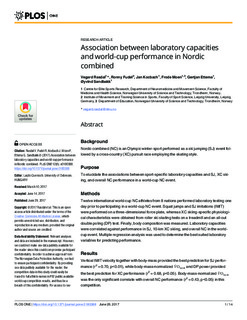| dc.contributor.author | Rasdal, Vegard | |
| dc.contributor.author | Fudel, Ronny | |
| dc.contributor.author | Kocbach, Jan | |
| dc.contributor.author | Moen, Frode | |
| dc.contributor.author | Ettema, Gertjan | |
| dc.contributor.author | Sandbakk, Øyvind | |
| dc.date.accessioned | 2017-09-18T06:45:16Z | |
| dc.date.available | 2017-09-18T06:45:16Z | |
| dc.date.created | 2017-09-14T12:28:30Z | |
| dc.date.issued | 2017 | |
| dc.identifier.issn | 1932-6203 | |
| dc.identifier.uri | http://hdl.handle.net/11250/2454990 | |
| dc.description.abstract | Background
Nordic combined (NC) is an Olympic winter-sport performed as a ski jumping (SJ) event followed by a cross-country (XC) pursuit race employing the skating style.
Purpose
To elucidate the associations between sport-specific laboratory capacities and SJ, XC skiing, and overall NC performance in a world-cup NC event.
Methods
Twelve international world-cup NC athletes from 8 nations performed laboratory testing one day prior to participating in a world-cup NC event. Squat jumps and SJ imitations (IMIT) were performed on a three-dimensional force plate, whereas XC skiing-specific physiological characteristics were obtained from roller ski skating tests on a treadmill and an all-out double poling (DP) test. Finally, body composition was measured. Laboratory capacities were correlated against performance in SJ, 10-km XC skiing, and overall NC in the world-cup event. Multiple regression analysis was used to determine the best suited laboratory variables for predicting performance.
Results
Vertical IMIT velocity together with body-mass provided the best prediction for SJ performance (r2 = 0.70, p<0.01), while body-mass-normalized and DP power provided the best prediction for XC performance (r2 = 0.68, p<0.05). Body-mass-normalized was the only significant correlate with overall NC performance (r2 = 0.43, p<0.05) in this competition.
Conclusion
Overall, the concurrent development of , upper-body power, and SJ-specific vertical jump capacity while minimizing body-mass within the BMI limit set by FIS should be considered in the seasonal training of NC athletes. | nb_NO |
| dc.language.iso | eng | nb_NO |
| dc.publisher | Public Library of Science | nb_NO |
| dc.rights | Navngivelse 4.0 Internasjonal | * |
| dc.rights.uri | http://creativecommons.org/licenses/by/4.0/deed.no | * |
| dc.title | Association between Laboratory Capacities and World-cup Performance in Nordic Combined | nb_NO |
| dc.type | Journal article | nb_NO |
| dc.type | Peer reviewed | nb_NO |
| dc.description.version | publishedVersion | nb_NO |
| dc.source.volume | 12 | nb_NO |
| dc.source.journal | PLoS ONE | nb_NO |
| dc.source.issue | 6 | nb_NO |
| dc.identifier.doi | 10.1371/journal.pone.0180388 | |
| dc.identifier.cristin | 1493716 | |
| dc.description.localcode | ©2017 Rasdalet al. This is an open access article distributed under the terms of the CreativeCommons Attribution License,which permits unrestricted use, distribution, and reproduction in any medium,provided the original author and source are credited | nb_NO |
| cristin.unitcode | 194,65,30,0 | |
| cristin.unitcode | 194,67,70,0 | |
| cristin.unitname | Institutt for nevromedisin | |
| cristin.unitname | Institutt for pedagogikk og livslang læring | |
| cristin.ispublished | true | |
| cristin.fulltext | original | |
| cristin.qualitycode | 1 | |

